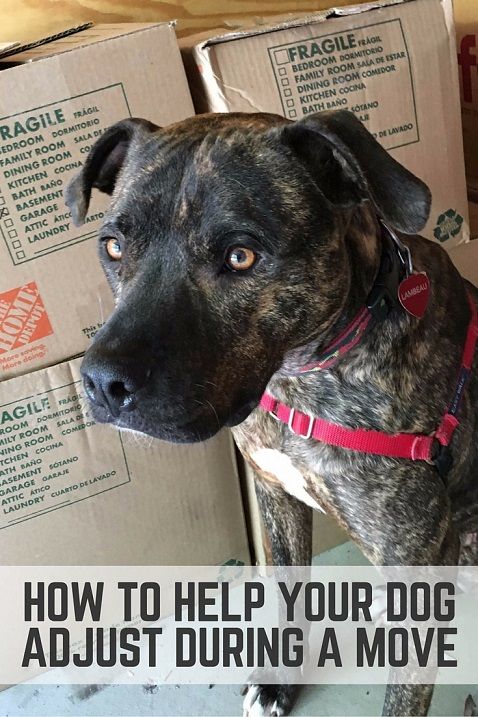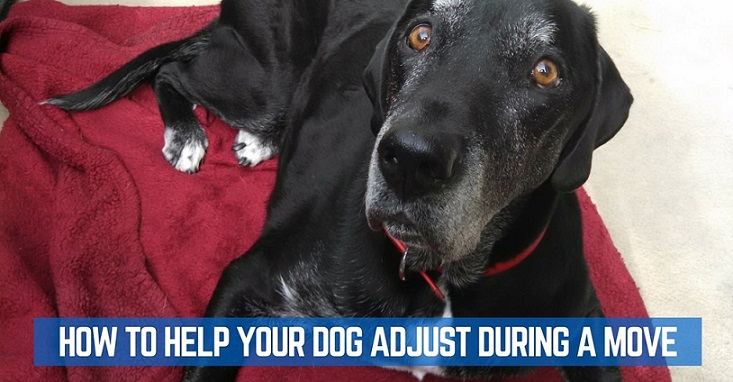M. A. Kropp is a contributor to That Mutt. She is an animal lover and enjoys working with her current dog, a pitull mix named Lambeau.
We moved to a new home a few months ago. It’s been a good thing, mainly because it has cut my husband’s commute time in half.
We are settled in and things are good, but there were days before the moving trucks showed up when I was sure the stress was going to be the end of me.
Moving is not only stressful on the human members of a family. Your dog will feel the stress, also. Boxes are everywhere, routines can be upended, and the general feeling of “something going on” takes its toll on a dog also.
There are things you can do that will make the transition easier on your pup. I’m going to give you a few tips to help your dog adjust during a move.
This post may contain affiliate links. That Mutt may earn money from the companies mentioned in this post.
6 tips to help your dog adjust during a move
1. Try not to change your dog’s routine.
Of course, there will be times that can’t be helped. That’s part of normal life even if you are not moving. But constant changes in routine will add to your dog’s stress and confusion.
Try to keep meals, walks, exercise, and other daily habits as close to normal as possible, both before and after you move.
You may be tempted to buy all new toys, beds, collars, and leashes to go with a new home. Don’t change it all.
Having familiar things with him will help comfort your dog. Keep his favorite toys, blanket or bed, and crate. You can gradually change them out for new later.
2. If you can, take him to the new area before you move.
Just a walk around a new neighborhood a few times will get him used to the new sights and smells.
If he’s used to going places with you and doing new things, this will be easier on him but a dog who stays home most of the time will benefit from a walk or two in a new neighborhood.
3. Keep your dog safely secured on moving day.
When moving day arrives, make sure your dog is securely contained, either in a room with a closed door or his crate. The room should be one that the movers won’t be in and out of constantly.
If you need to, have them empty this room first, and then put your dog in there with his bed, water, and a toy or two.
Put a sign on the door to remind everyone not to let the dog out. Or move his crate to a spot that is out of the way of the main activity and put him in there. A blanket put over the crate, at least partly covering it can help him feel more secure, especially if he gets nervous easily.
Sometimes, it’s better for everyone if you either board your dog for a day or two, or take him to doggie daycare while the actual moving is taking place.
You can concentrate on the movers and other last minute details, and your dog will be out of the stress and commotion.
4. Once moved, put your dog’s things in familiar places.
Once you are moved into the new place, try to put his food, water, crate, and other items in familiar places. If he always had water in the kitchen, put his water bowl in the new kitchen.
If his crate or bed was always in the living room where you sit and relax, put them there in the new house.
You can begin to move him to a new location later if that is your plan, but at first, you want the new house to feel at least somewhat familiar.
Make sure he wears a collar with an ID tag with your new information on it all the time, at least for a while. Even if he doesn’t usually wear his collar in the house, it’s a good precaution just in case he gets scared and runs off. If he has a microchip, make sure to update that information also.
6. Be patient with him.
Anxiety can cause some dogs to regress on training. He may forget his housetraining temporarily, or seem to not remember behaviors he knew solidly before the move. Don’t punish him for mistakes.
If it’s a housetraining problem, go back to taking him out for more often potty breaks again. If he seems to have lost some of his other training, get out your clicker and treats (or whatever training method you use), and do some reinforcing.
Not only will it remind him of proper behavior, but it will also strengthen your bond with your dog, and help to reassure him that things are fine, even if everything looks and smells different.
Moving is a big change for everyone, but just like you plan your packing and moving ahead of time, a little thought and planning for your dog will help the move go smoothly for him, too.
What other ideas would you add to this list?
Let us know in the comments!
Related post:
Why do people give up their pets when they move?



Jenna
Tuesday 4th of October 2016
I recently moved and my dog Annie is not handling it well. She howls from when I leave until I get home. My neighbor told me it sounds as though her heart is breaking. She has never been alone before. She came from Puerto Rico with her mom, sisters, and brother, moved in with cats and other dogs, but now is the only pet besides a lizard.)
My vet does not think she will break the severe separation anxiety and I'm trying to find any possible solutions to help her. Getting another dog isn't an option because I am scared my dog will teach that one to bark.
scott wollins
Tuesday 4th of October 2016
One dog - moves like a champ - the other - goes on starvation diet - we move alot compared to most people - although the moving champ is loosing his sight (PRA) - so we are looking to settle down at some point in next year - best thing to do - is love them alot before, during, and after move - your love never moves
Colby
Wednesday 8th of June 2016
Linus is my worrier. When we moved a few years ago I brought him over to the new house several times before our permanent move. I was worried that Linus would freak out because of the new smells, new neighborhood, and change after nearly 10 years in the same home. On top of it all we had a creaky roof that would unexplainably crack every few hours. Fortunately, Linus had no problems adjusting to the new house. Maybe he just liked the fact that he went from a little patio to a fully backyard :)
Mal
Wednesday 8th of June 2016
Moving was stressful for my dog. He is normally very well behaved, but for the first time ever, he stole a bag of his treats, which he then chewed through. Later, of course, his stomach was not happy with him. We had to leave him in the backyard during loading and he barked his head off the whole time. It was annoying (sorry, neighbors!), but the only way to keep him safe during the loading of the truck. At the house we moved to, we left him in the car, which he actually preferred (or maybe he was tired of barking by then). Finally, on his first day in the new house, he rolled in something truly disgusting in the backyard. I had no idea how hard moving would be for him, so we didn't take any steps to make it easier for him. Next time we move, he is spending the day with a friend!
Lindsay Stordahl
Wednesday 8th of June 2016
Oh gosh, poor guy! Haha.
Sylv
Tuesday 7th of June 2016
At the time of our last move we only had one dog. Suki went to doggie daycare once a week. We researched and visited the available daycares near the new location, and arranged for an assessment with the one we liked best (free supervised play all day with a one-hour quiet time in the afternoon, as opposed to the other option where she would have been crated most day - no thanks!).
The day of the move she stayed with friends, but as we had big renovations scheduled for the first little while, we were glad to be able to take her to the daycare on days that a lot of activity or noise was expected.
Lindsay Stordahl
Tuesday 7th of June 2016
Sounds like she really enjoyed her time at daycare too!